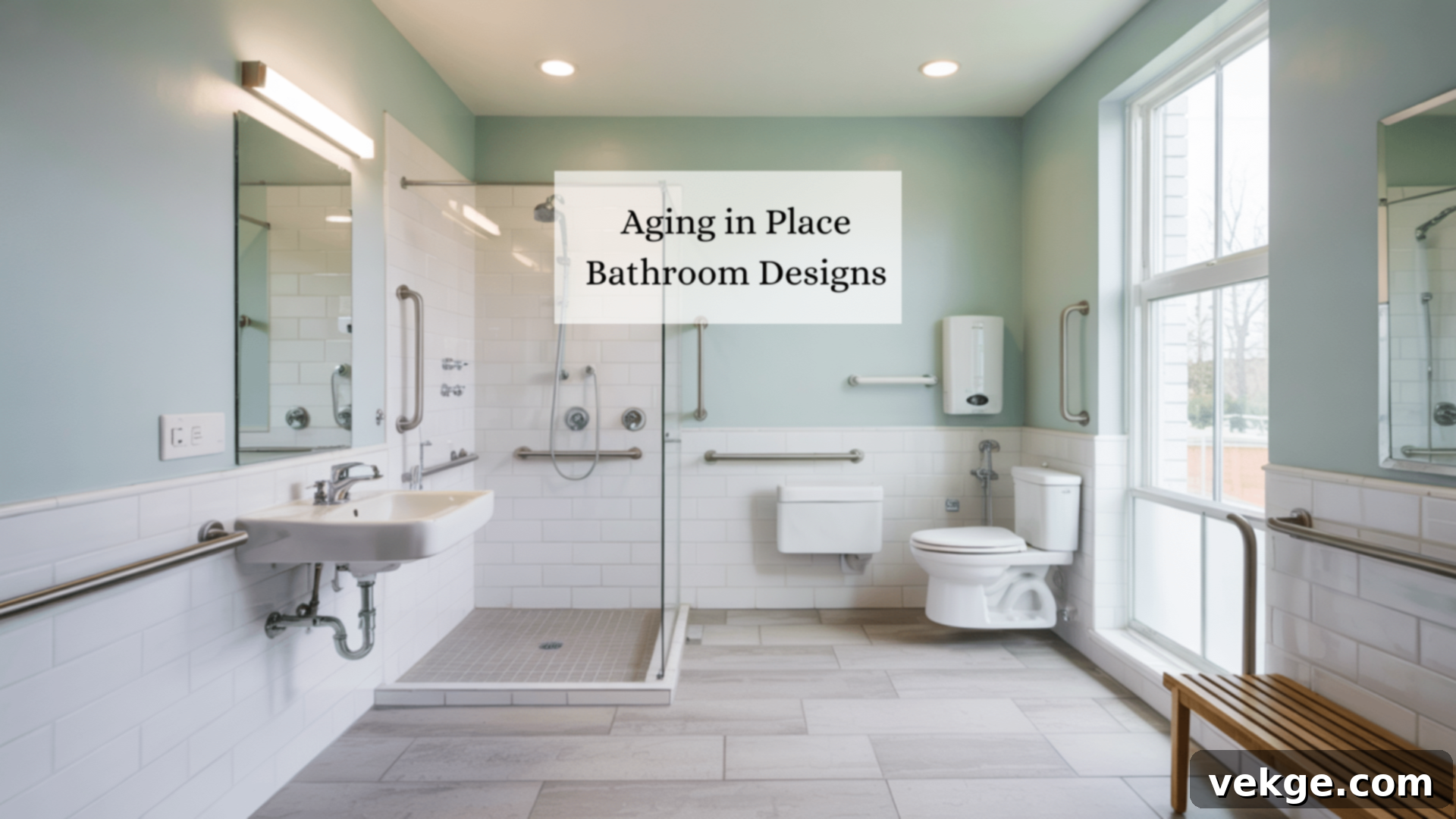Transform Your Bathroom: The Ultimate Guide to Aging-in-Place Design for Safety, Comfort, and Independence
The bathroom is often considered one of the most dangerous rooms in the house, particularly as we age. For many, the thought of losing independence or facing serious injury from a fall is a growing concern. Statistics show that a significant number of falls among older adults happen right here, in familiar surroundings. But what if you could transform this space into a sanctuary of safety and comfort, allowing you to live independently in your beloved home for years to come?
This is where aging-in-place bathroom design comes in. Far from being clinical or institutional, these thoughtful designs seamlessly integrate essential features that make daily routines easier, safer, and more enjoyable for people of all ages and abilities. The goal is simple: to create a functional yet stylish environment that adapts to your changing needs, ensuring peace of mind without compromising on aesthetics.
In this comprehensive guide, we’ll explore the foundational principles of aging-in-place bathrooms, from crucial accessibility elements to clever safety enhancements and unparalleled comfort features. We’ll dive deep into smart design tips, offering practical solutions and innovative ideas that can elevate your bathroom’s functionality. Furthermore, we’ll provide essential maintenance advice to keep your modifications in top condition and highlight the latest trends shaping accessible bathroom design. By the end, you’ll be equipped with the knowledge to create a bathroom that is not only beautiful but also a cornerstone of your long-term independence and well-being.
Key Pillars of Aging-in-Place Bathroom Design: Accessibility, Safety, and Comfort
Designing a bathroom for aging-in-place is a holistic approach, focusing on three fundamental pillars: accessibility, safety, and comfort. These elements work in synergy to create a space where daily routines are not just manageable but genuinely enjoyable, promoting sustained independence and dignity for every user.
Prioritizing Accessibility: Effortless Entry and Movement
Accessibility is the cornerstone of any aging-in-place bathroom, ensuring that the space is easy to enter, navigate, and utilize for individuals with varying mobility levels. This means thoughtfully removing barriers and optimizing the layout to accommodate current and future needs. Considerations include:
- Barrier-Free Entry: Eliminating steps, high thresholds, or curbs at the bathroom entrance and into the shower is paramount. This allows for seamless transitions for individuals using walkers, wheelchairs, or simply those with unsteady gaits, significantly reducing the risk of tripping.
- Ample Maneuvering Space: Sufficient clear floor space is crucial, typically recommending a minimum turning radius of 60 inches for wheelchairs. This ensures that users can move freely between the toilet, sink, and shower without feeling cramped or bumping into fixtures, making the bathroom functional for all types of mobility aids.
- Optimized Fixture Heights: Sinks, showers, and toilets should be installed at heights that minimize bending, stretching, or straining. Comfort-height toilets, adjustable-height sinks, and handheld showerheads on sliding bars are excellent examples, accommodating users who may be seated or standing, or who have limited range of motion.
- Wide Doorways: Ensuring doorways are at least 32 inches wide (preferably 36 inches) allows easy passage for wheelchairs and walkers, or for a caregiver to assist if needed.
Enhancing Safety: Preventing Falls and Ensuring Security
Safety in the bathroom goes beyond mere convenience; it’s about proactively preventing accidents and providing peace of mind. Given the slippery surfaces and potential hazards, specific design choices can dramatically reduce risks:
- Non-Slip Surfaces: The choice of flooring is critical. Non-slip tiles, textured vinyl, or treated concrete can significantly improve traction, especially when wet. Applying anti-slip coatings to existing surfaces is another effective solution.
- Strategically Placed Grab Bars: Robust grab bars are essential near the toilet, inside and outside the shower/bathtub, and wherever extra support is needed. These should be securely installed into wall studs and capable of supporting significant weight, offering reliable assistance for standing, sitting, or maintaining balance.
- Bright and Even Lighting: Good illumination is vital to see obstacles and reduce shadows. A combination of overhead, task, and night lighting ensures that all areas are well-lit at all times, preventing trips and enhancing visibility for tasks like shaving or applying makeup.
- Easy-to-Use Controls: Faucets with lever handles or touch/motion sensors, and light switches with large rockers or motion activation, are ideal for individuals with limited dexterity, arthritis, or reduced grip strength. Thermostatic valves can prevent scalding by maintaining a consistent water temperature.
- Emergency Features: Integrating safety alarms or emergency call buttons within easy reach near the toilet and shower provides an immediate link to help in case of an unforeseen incident, offering immense reassurance.
Maximizing Comfort: A Relaxing and Restorative Experience
Beyond basic accessibility and safety, an aging-in-place bathroom should prioritize comfort, making every visit a pleasant and less strenuous experience. Comfort-focused features contribute to overall well-being and encourage regular self-care:
- Comfort-Height Toilets and Seating Options: Higher toilet seats reduce the effort required to sit and stand. In-shower seating, such as built-in benches or fold-down seats, allows users to rest while bathing, conserving energy and reducing the risk of fatigue-related falls.
- Adjustable Fixtures: Showerheads that can be adjusted for height, or even detachable handheld wands, provide flexibility for users of different statures or those who prefer to shower while seated. Adjustable-height sinks also cater to diverse user needs.
- Ergonomic Layout: A well-planned layout minimizes unnecessary stretching, twisting, and reaching. Keeping frequently used items within arm’s reach and creating a circular flow reduces strain on joints and muscles, particularly beneficial for individuals with back pain or limited mobility.
- Temperature Control: Radiant floor heating can add a touch of luxury and comfort, especially in colder climates, making bare feet on tile a more pleasant experience.
- Comfortable Surfaces: While prioritizing non-slip properties, selecting flooring and finishes that are also pleasant to the touch can enhance the overall comfort of the space.
21 Smart Design Tips to Elevate Your Aging-in-Place Bathroom
Achieving a bathroom that seamlessly combines accessibility, safety, and comfort is easier than you might think. Many intelligent design solutions are available, ranging from minor updates to more significant renovations, all aimed at enhancing your daily experience. These smart tips not only cater to the needs of older adults but also embrace the principles of universal design, benefiting every member of the household and visitors alike. Let’s explore these innovative ideas that can transform your bathroom into a truly adaptable and inviting space.
1. Accessible Low-Cabinetry
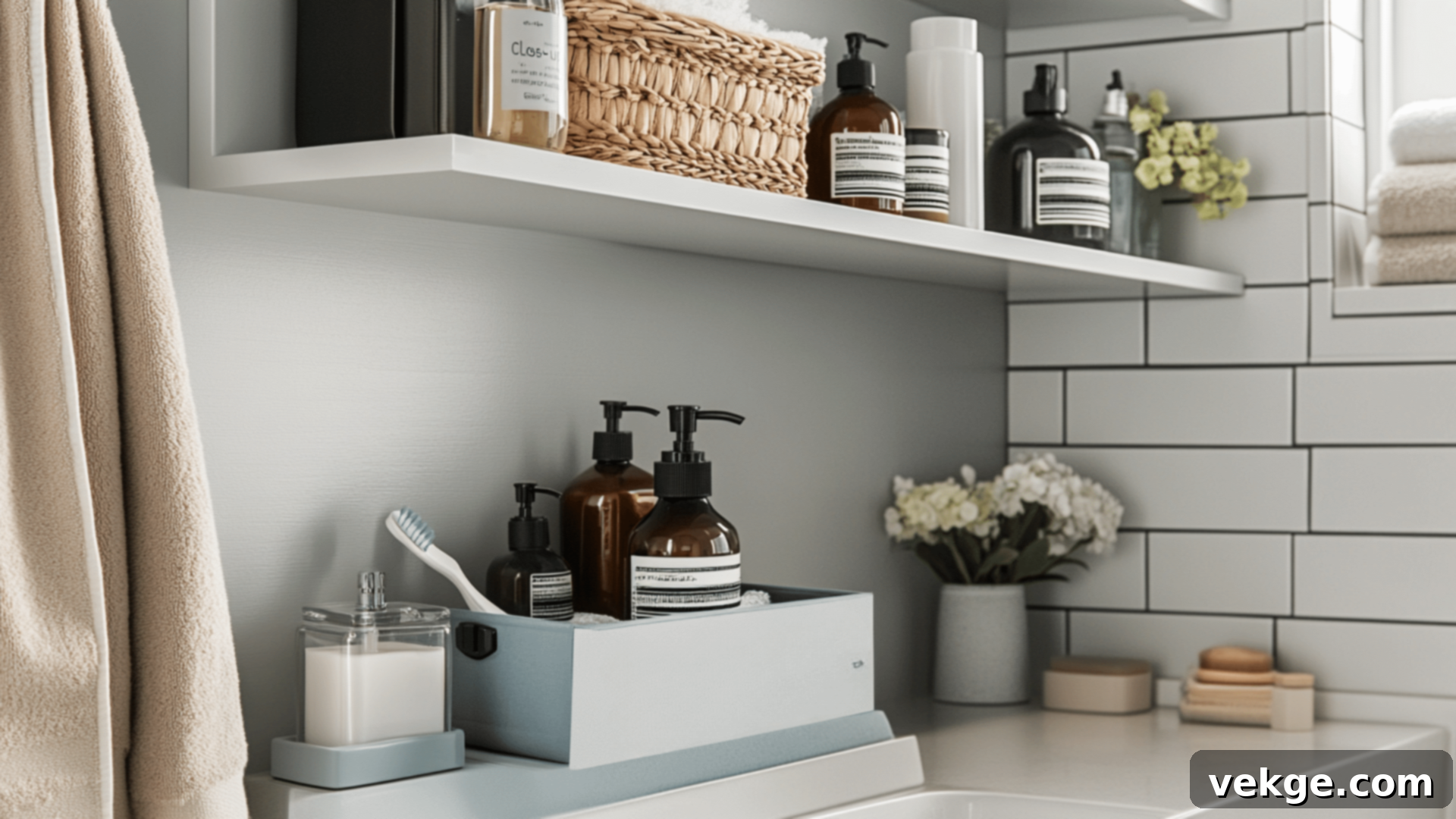
Traditional bathroom cabinetry often places essential items out of reach for many, particularly those using wheelchairs, individuals of shorter stature, or anyone with limited mobility in their shoulders or arms. Installing cabinets at a lower height or opting for floating vanities that accommodate knee space dramatically improves accessibility.
These thoughtful designs ensure that toiletries, towels, and other daily necessities are always within a comfortable arm’s reach, eliminating the need for awkward stretching, risky climbing on step stools, or relying on assistance. Low-cabinetry not only enhances safety by reducing potential fall hazards but also fosters greater independence, empowering users to manage their personal care routines with ease and dignity.
2. Convenient Pull-Out Drawers and Shelves
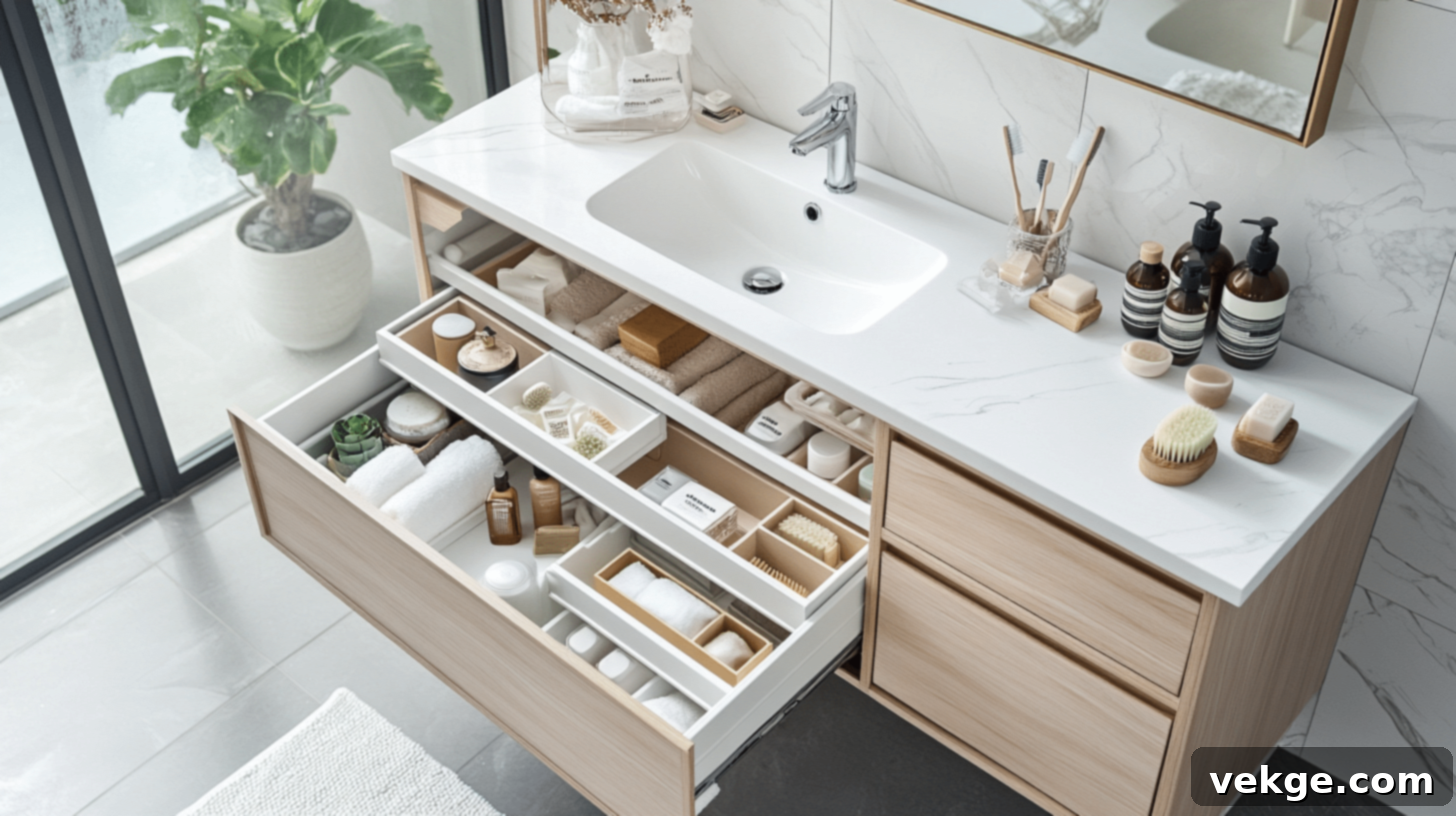
Deep cabinets can become black holes where items get lost and retrieving them requires uncomfortable bending and reaching. Pull-out drawers and shelves are revolutionary for organization and accessibility. These mechanisms allow the entire contents of a cabinet or pantry to slide forward, bringing everything into clear view and within easy grasp.
This design feature eliminates the strain on backs and knees associated with rummaging, making it effortless to access medications, cleaning supplies, or personal care products. They can be seamlessly integrated into new cabinetry or easily retrofitted into existing units, providing an immediate upgrade to your bathroom’s functionality and user-friendliness for people with arthritis or mobility challenges.
3. Practical Open Shelving
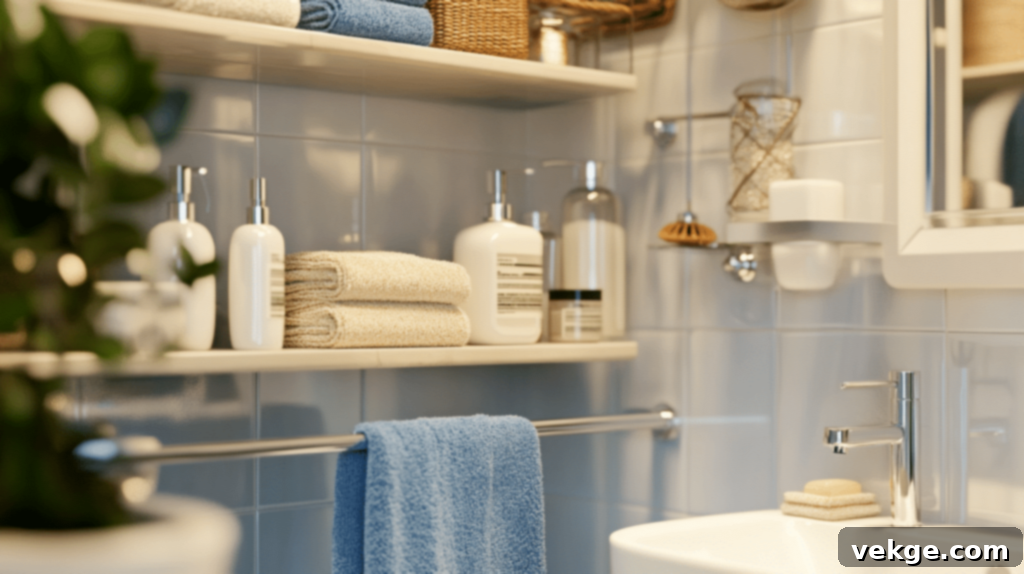
Open shelving offers immediate, unhindered access to frequently used items, making it an excellent choice for an aging-in-place bathroom. By removing cabinet doors and handles, individuals with limited hand dexterity, arthritis, or grip strength can effortlessly reach what they need without fumbling or straining.
Beyond its functional advantages, open shelving contributes to a more spacious and airy feel in the bathroom, allowing users to visually survey their essentials at a glance. It’s perfect for displaying neatly folded towels, organizing toiletries, or housing decorative accents, blending practical accessibility with modern aesthetic appeal.
4. Efficient Lazy Susans for Corners
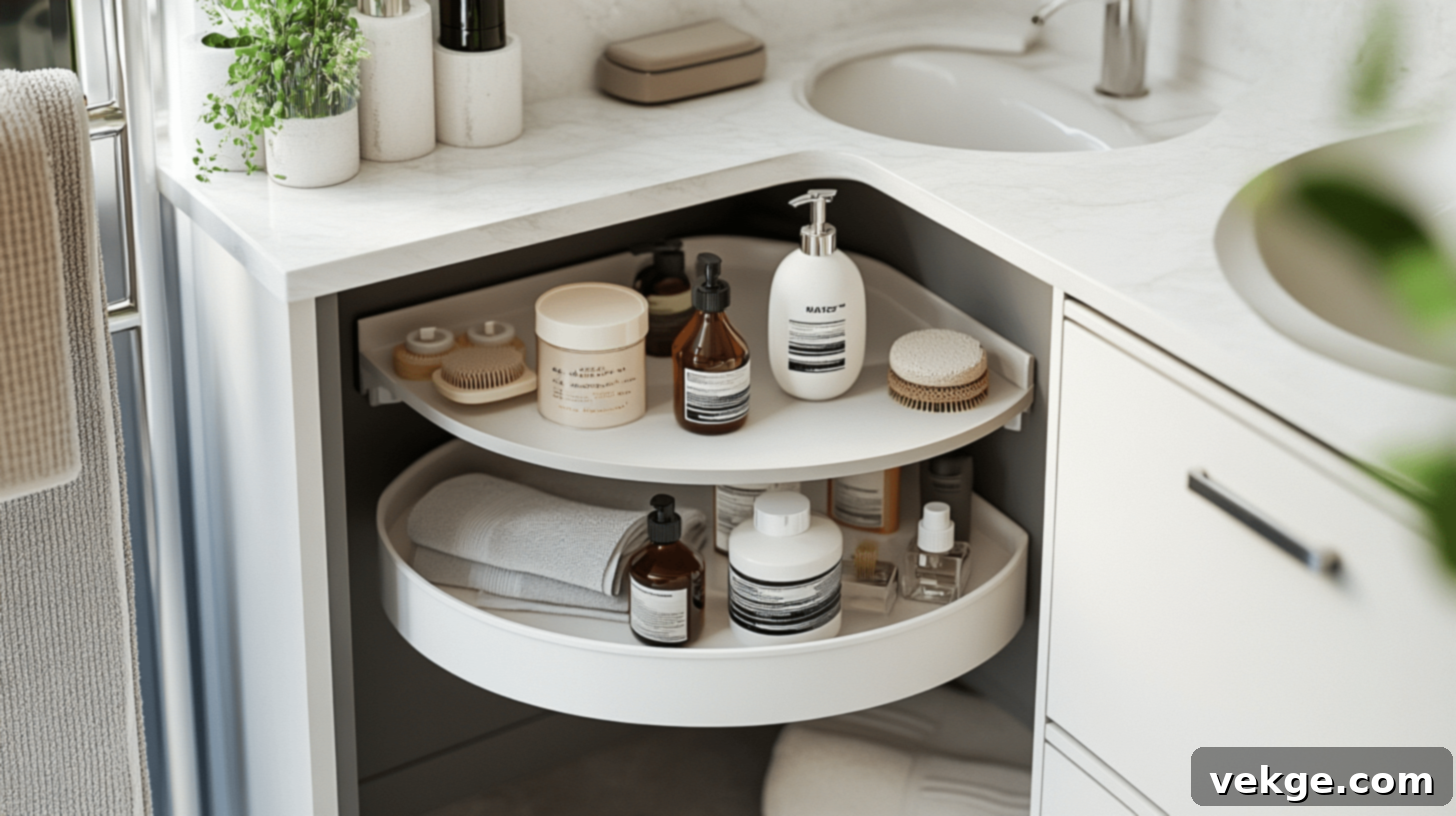
Corner cabinets and under-sink areas are notorious for becoming cluttered and hard to access. Lazy Susans, or rotating turntables, are ingenious solutions that transform these awkward spaces into highly functional storage zones. With a gentle spin, items from the deepest recesses of the cabinet are brought effortlessly to the front.
This design feature is particularly beneficial for those with limited reach or difficulty bending, as it eliminates the need to stretch or strain. Lazy Susans maximize usable storage space, keep small items organized, and ensure that everything from cleaning supplies to personal care products is easily discoverable and accessible, reducing frustration and potential hazards.
5. Innovative Pull-Down Shelves
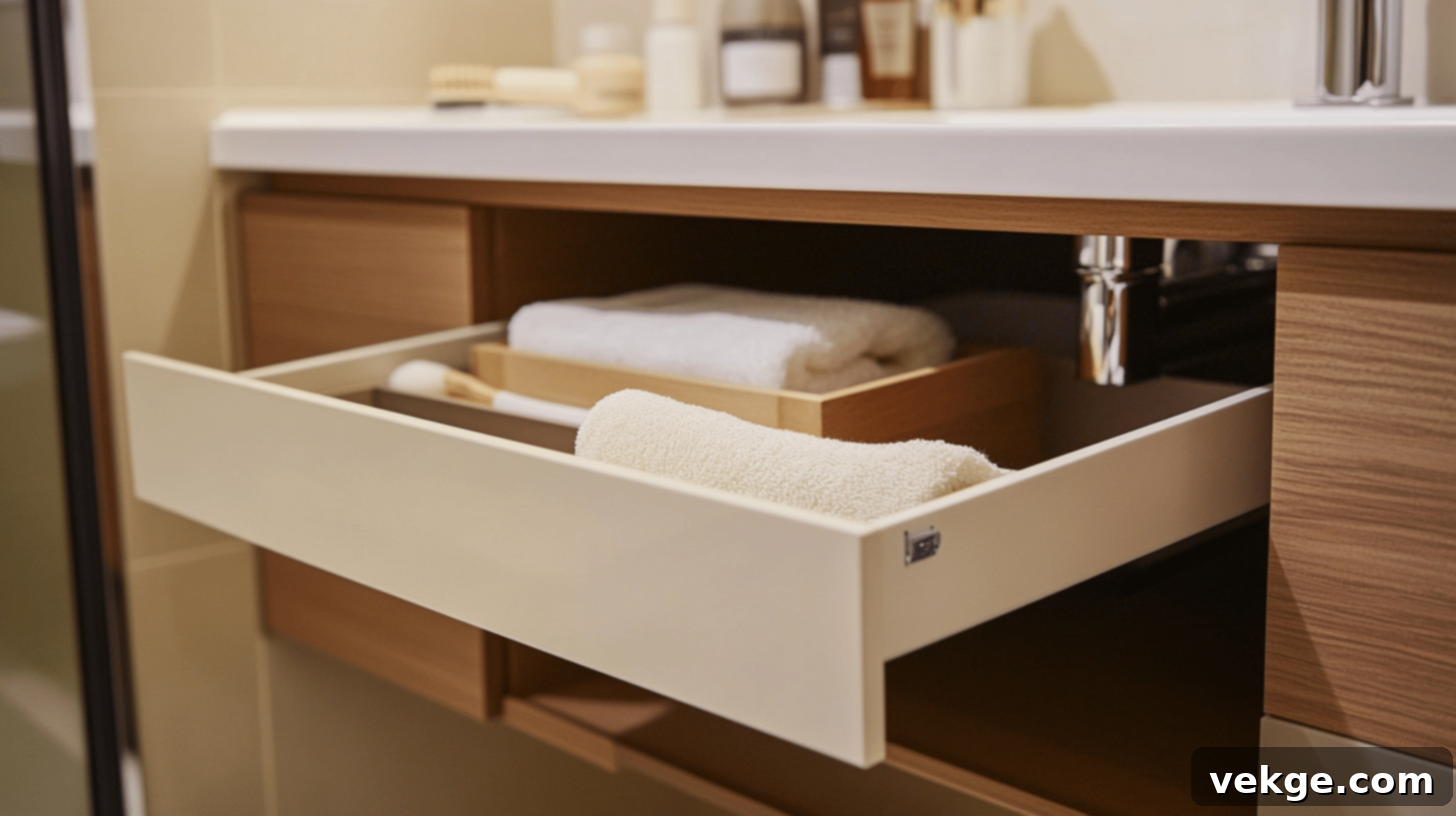
Utilizing vertical space in a bathroom is excellent for storage, but traditional high shelves can be inaccessible for many. Pull-down shelves are a smart, ergonomic solution, allowing users to gently pull an entire shelf unit down to a comfortable height. Once the items are retrieved or stored, the shelf smoothly retracts back into its elevated position.
This feature is a game-changer for individuals of shorter stature, wheelchair users, or anyone for whom reaching overhead is challenging or unsafe. It eliminates the risks associated with climbing on unstable stools and makes efficient use of upper wall space that might otherwise remain underutilized, offering both convenience and enhanced safety.
6. Versatile Height-Adjustable Sink
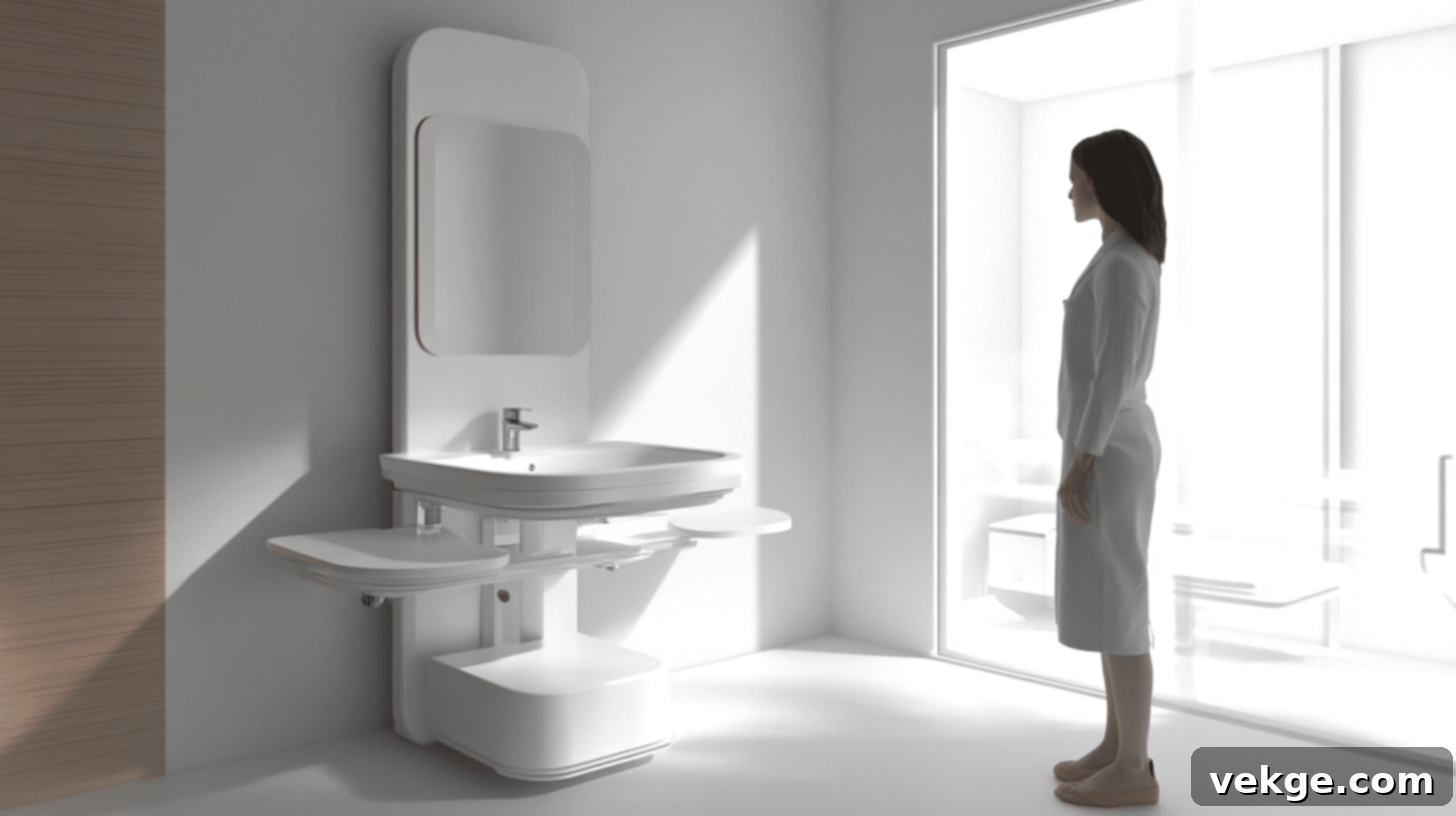
The standard sink height doesn’t work for everyone. A height-adjustable sink is a remarkable feature in a truly universal design bathroom. Operated by an electric lift system or a simple hand crank, these sinks can be raised or lowered to perfectly accommodate the user’s specific needs, whether they are standing, seated in a wheelchair, or require a specific ergonomic posture.
This adaptability means taller individuals avoid uncomfortable stooping, while wheelchair users can easily roll underneath without obstruction, accessing the faucet and basin comfortably. It’s an ideal solution for multi-generational homes or facilities catering to diverse users, ensuring optimal comfort and independence for personal grooming tasks.
7. Flexible Height-Adjustable Showerhead
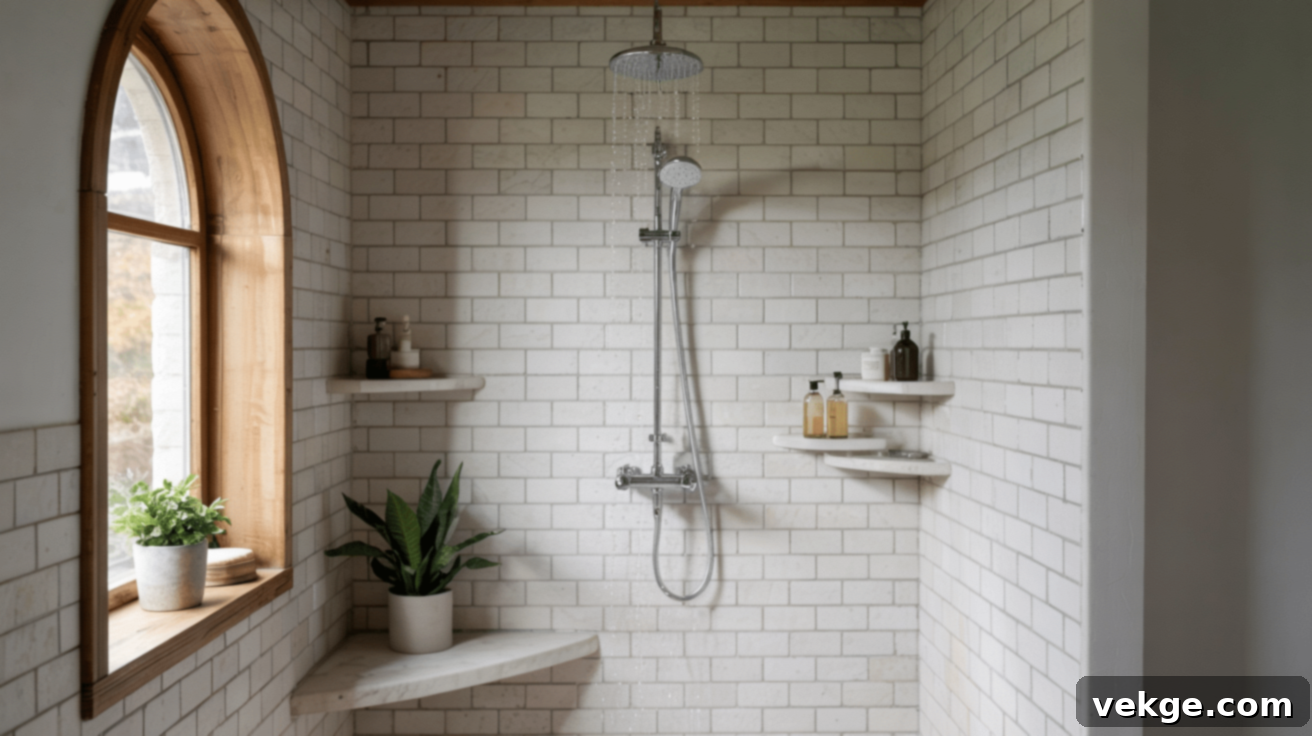
A fixed showerhead can be inconvenient and even unsafe for people of varying heights or those who need to shower while seated. A height-adjustable showerhead, typically mounted on a vertical slide bar, offers unparalleled flexibility. It can be easily repositioned up or down to suit the user’s height or preference, or detached for use as a handheld spray.
This simple yet impactful upgrade significantly enhances comfort and control, making showering a much more pleasant experience for everyone, from children to adults with mobility challenges. It’s also invaluable for assisted bathing or for tasks like washing pets, ensuring water can be directed precisely where needed without awkward stretching or bending.
8. User-Friendly Flexible Faucet Handles
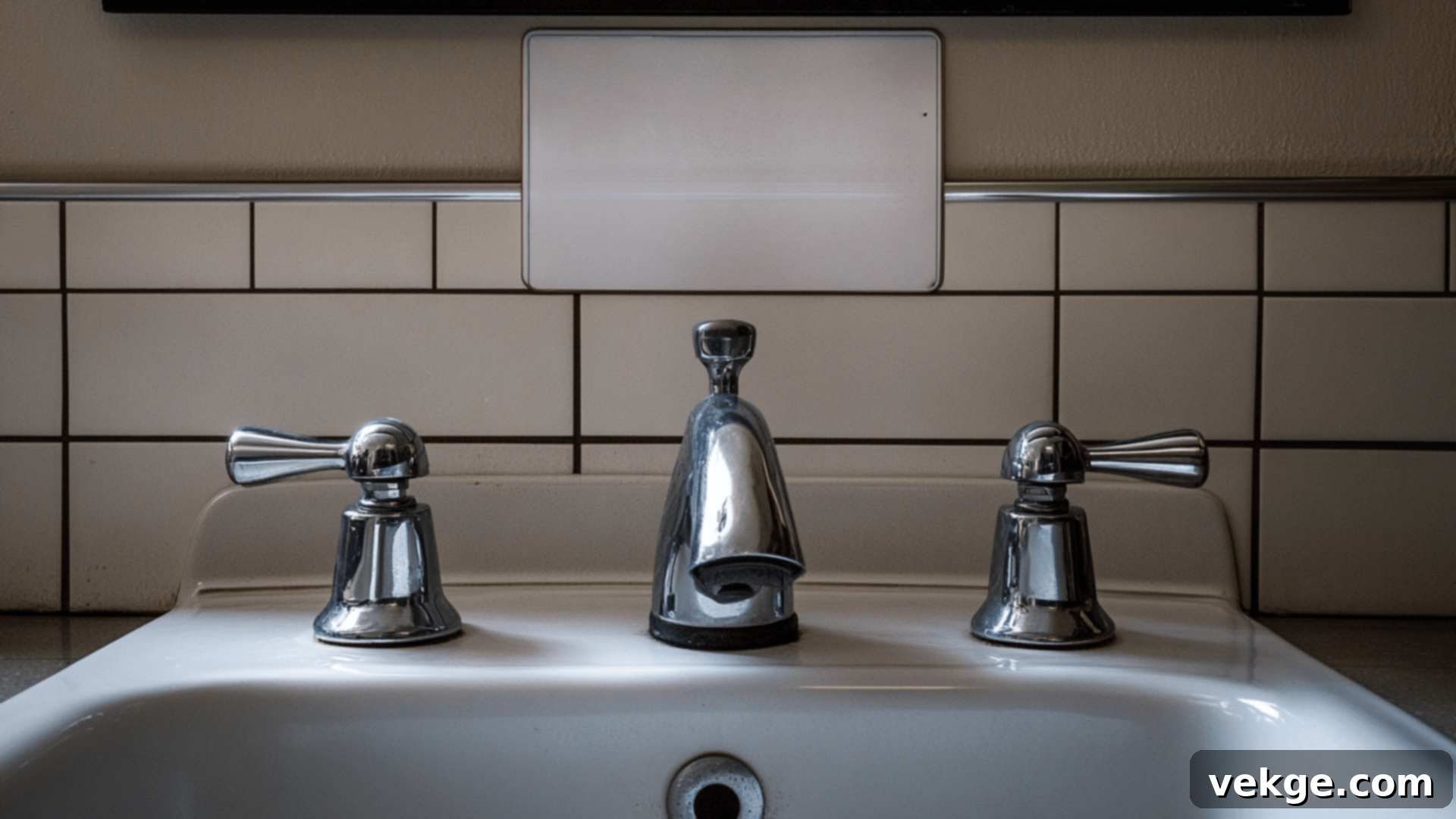
Traditional twist-knob faucets can be a source of frustration and pain for individuals with arthritis, carpal tunnel syndrome, or limited hand dexterity. Flexible faucet handles, such as lever-style handles or paddle designs, offer a much more ergonomic solution. They require minimal grip strength and can be operated with just a gentle push of the hand, wrist, or even forearm.
These accessible faucets are available in a vast array of finishes and styles, ensuring that safety and ease of use do not come at the expense of design aesthetics. Upgrading to lever handles is a straightforward and cost-effective way to improve the functionality of your sink, making daily handwashing and grooming tasks effortlessly manageable for all ages and abilities.
9. Hygienic Motion-Sensor Faucets
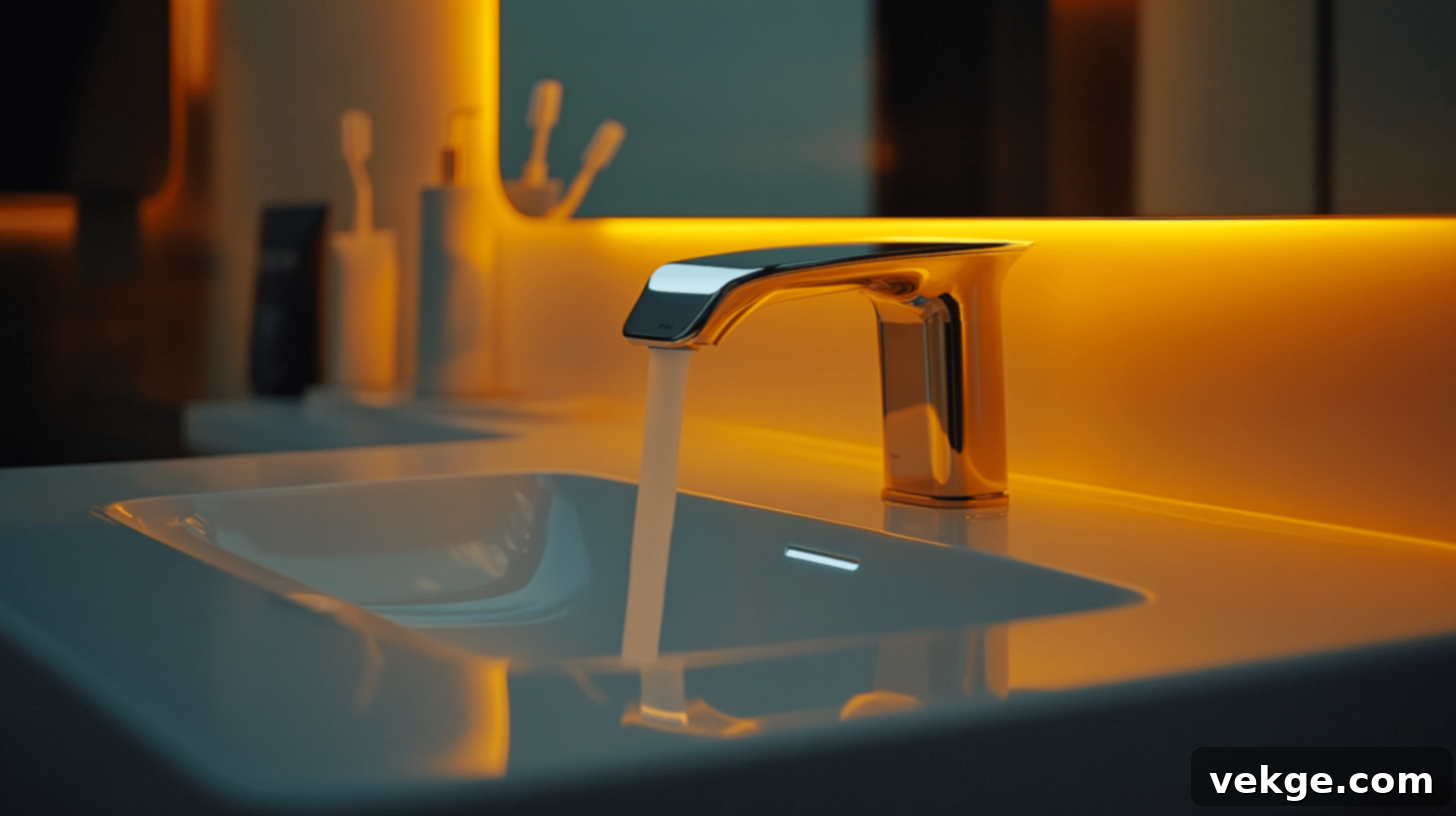
Taking convenience and hygiene to the next level, motion-sensor faucets activate water flow automatically when hands are placed beneath them and cease when hands are removed. This touchless operation is a significant advantage in an aging-in-place bathroom, eliminating the need to grip or turn handles altogether.
Beyond the enhanced accessibility for those with limited hand mobility, these faucets offer superior hygiene by reducing the transfer of germs, as no physical contact with the faucet itself is required. They also contribute to water conservation by only running when needed. Modern designs are sleek and discreet, blending seamlessly into contemporary bathroom aesthetics while providing a highly practical and sanitary solution.
10. Secure Built-In Shower Bench
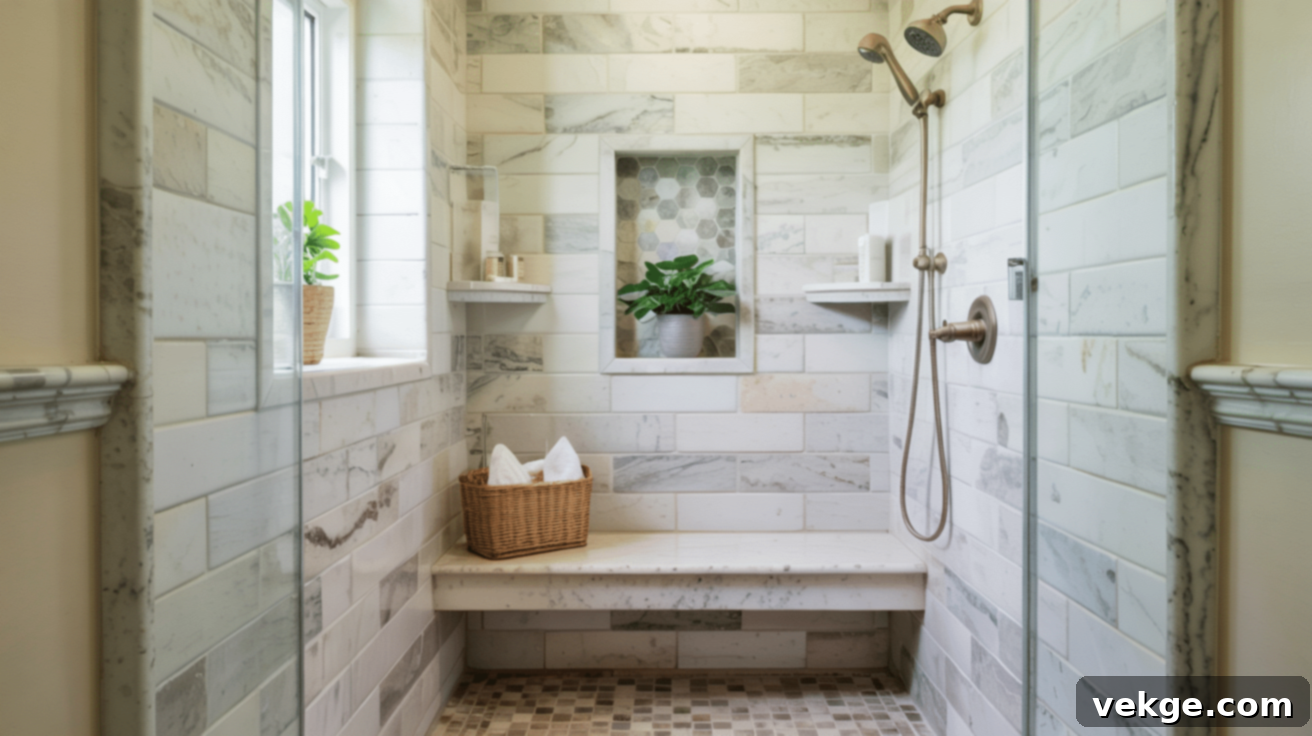
For individuals who experience fatigue, have balance issues, or simply prefer to sit while showering, a built-in shower bench is an invaluable addition. Unlike portable shower chairs that can be unstable or take up floor space, a permanently installed bench offers unwavering stability and support, significantly enhancing safety and comfort.
These benches can be integrated into the shower design using the same tiles or materials, creating a cohesive and luxurious look. Beyond providing a safe seating option, a built-in bench also serves as a convenient shelf for shower essentials or a footrest for shaving. It’s a thoughtful feature that promotes longer, more relaxed showers without the worry of standing fatigue or slips.
11. Space-Saving Fold-Down Wall Seat
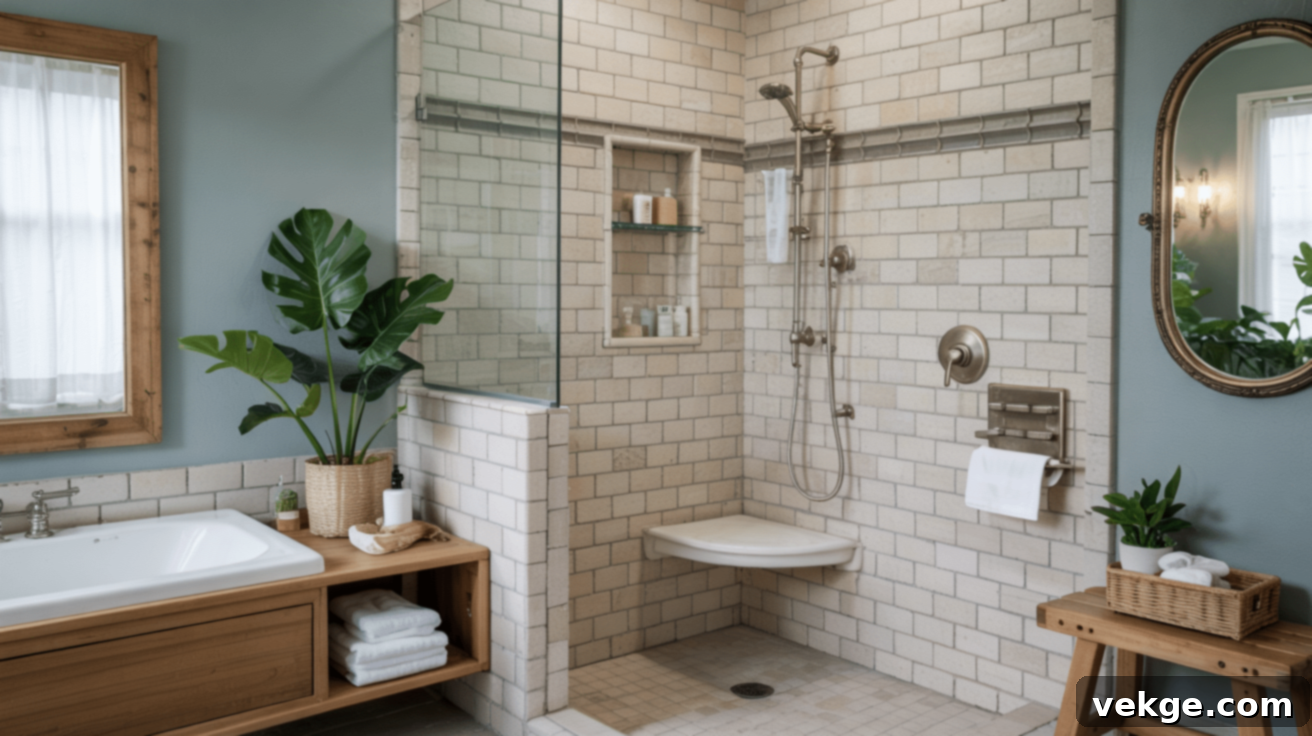
When shower space is limited, or for showers used by both standing and seated individuals, a fold-down wall seat offers the perfect blend of functionality and flexibility. Securely mounted to the shower wall, these seats can be easily lowered for use and then neatly folded back up against the wall when not needed.
This clever design maximizes precious shower real estate while still providing a safe and stable seating option for those who need it. It’s an excellent alternative to a built-in bench when space is at a premium, ensuring that the bathroom remains adaptable to various needs without compromising on the ability to comfortably and safely bathe.
12. Enhanced Comfort with a Padded Toilet Seat
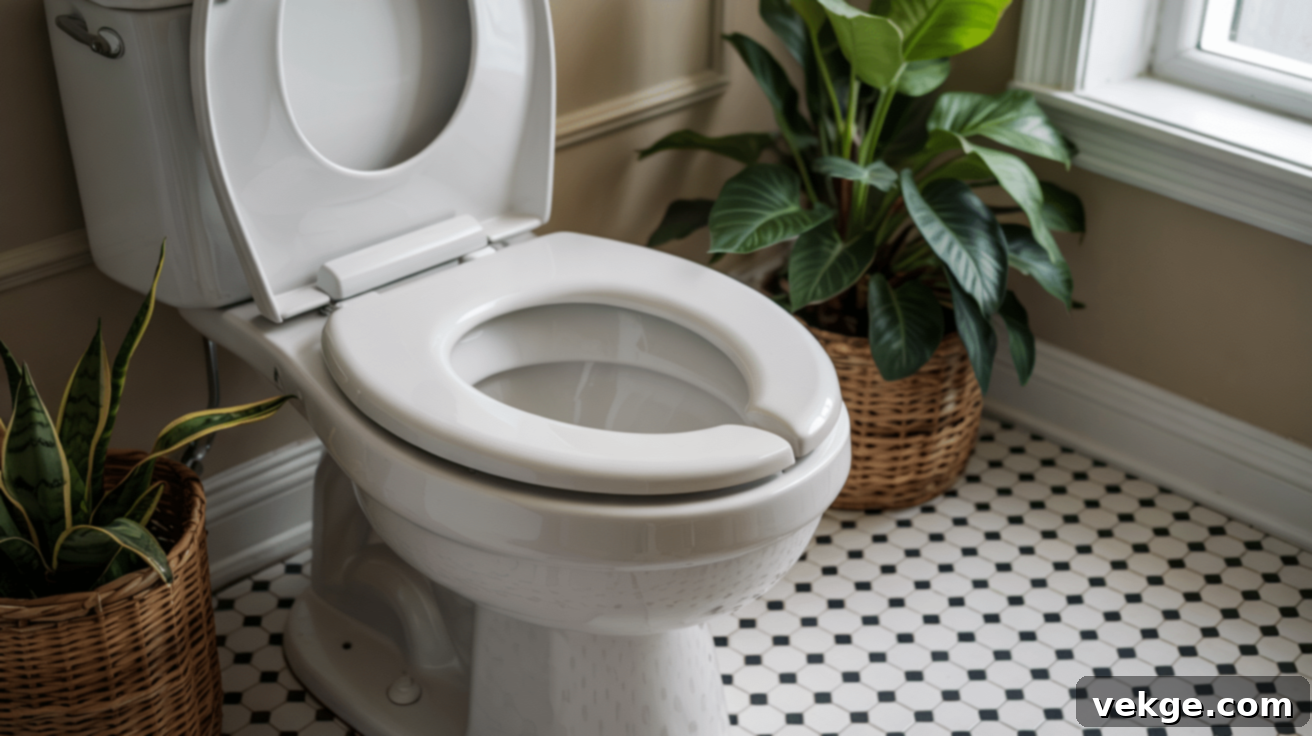
While often overlooked, a padded toilet seat can significantly enhance comfort, particularly for individuals who spend extended periods on the toilet or have sensitive skin or bony frames. The soft cushioning helps to distribute weight more evenly, reducing pressure points and preventing discomfort or soreness that can arise from hard, unforgiving surfaces.
Padded seats are simple to install and come in a variety of materials, colors, and designs to complement any bathroom decor. This minor alteration offers a substantial improvement in comfort and can be a thoughtful detail in an aging-in-place bathroom, contributing to overall well-being without requiring extensive renovation.
13. Spacious Open Floor Plan
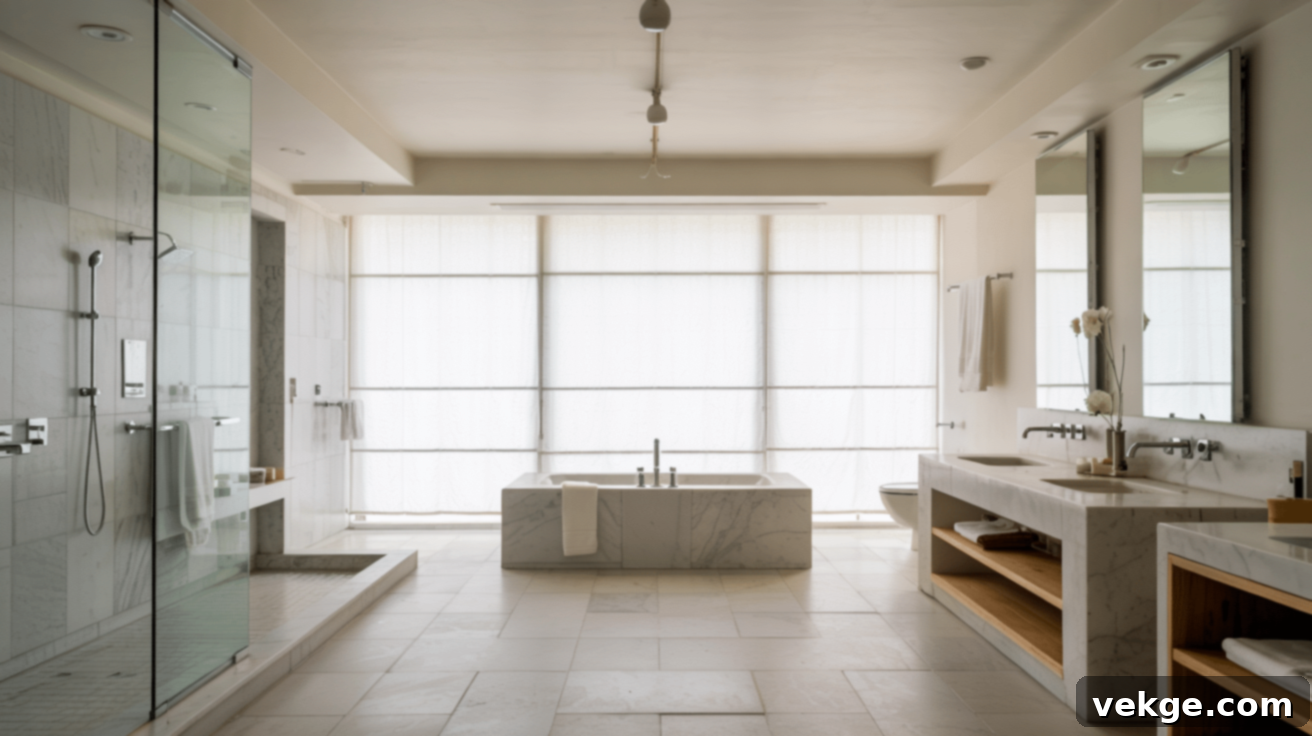
An open floor plan is a hallmark of universal design, promoting effortless mobility and a feeling of spaciousness in the bathroom. By minimizing unnecessary walls, partitions, and cluttered fixtures, this layout creates expansive clear pathways, making it easy for individuals using wheelchairs, walkers, or other mobility aids to navigate without obstruction.
Beyond its practical advantages for accessibility, an open floor plan also contributes to a more inviting and less confining atmosphere. It allows ample space for caregivers to assist if necessary and generally enhances the overall functionality and safety of the bathroom by reducing potential bumping hazards and facilitating a smooth flow of movement, which is essential for preventing falls.
14. Optimized Circular Flow and Layout
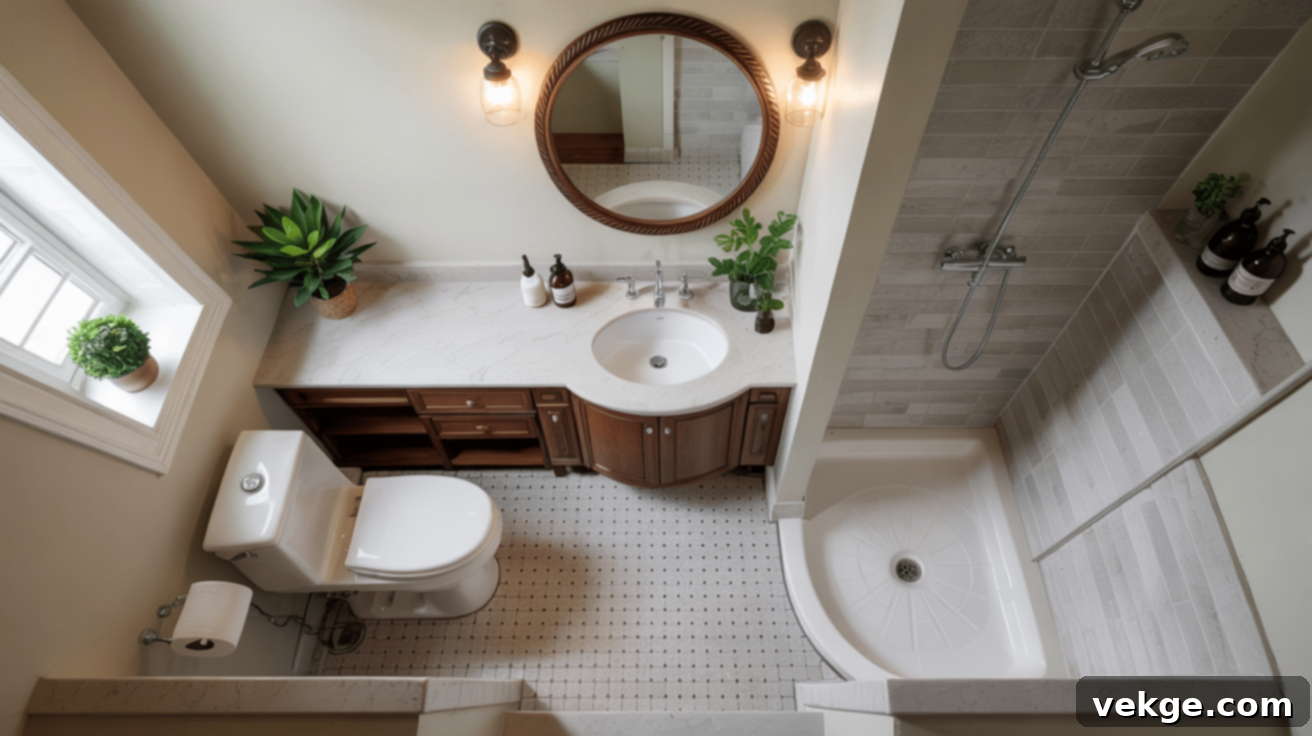
Designing a bathroom with a clear, circular flow is a highly effective strategy for improving ease of use and safety. This layout minimizes the need for awkward backing up, tight turns, or shuffling around obstacles, which can be particularly challenging for those with mobility impairments or when assisting another person.
By strategically positioning the sink, toilet, and shower/tub in a logical sequence that allows for a smooth, continuous movement path, users can transition between different areas effortlessly. This thoughtful planning reduces the risk of accidental bumps, scrapes, or falls, making the bathroom experience more efficient, less stressful, and safer for everyone, regardless of the bathroom’s size.
15. Safe and Stylish Curbless Shower
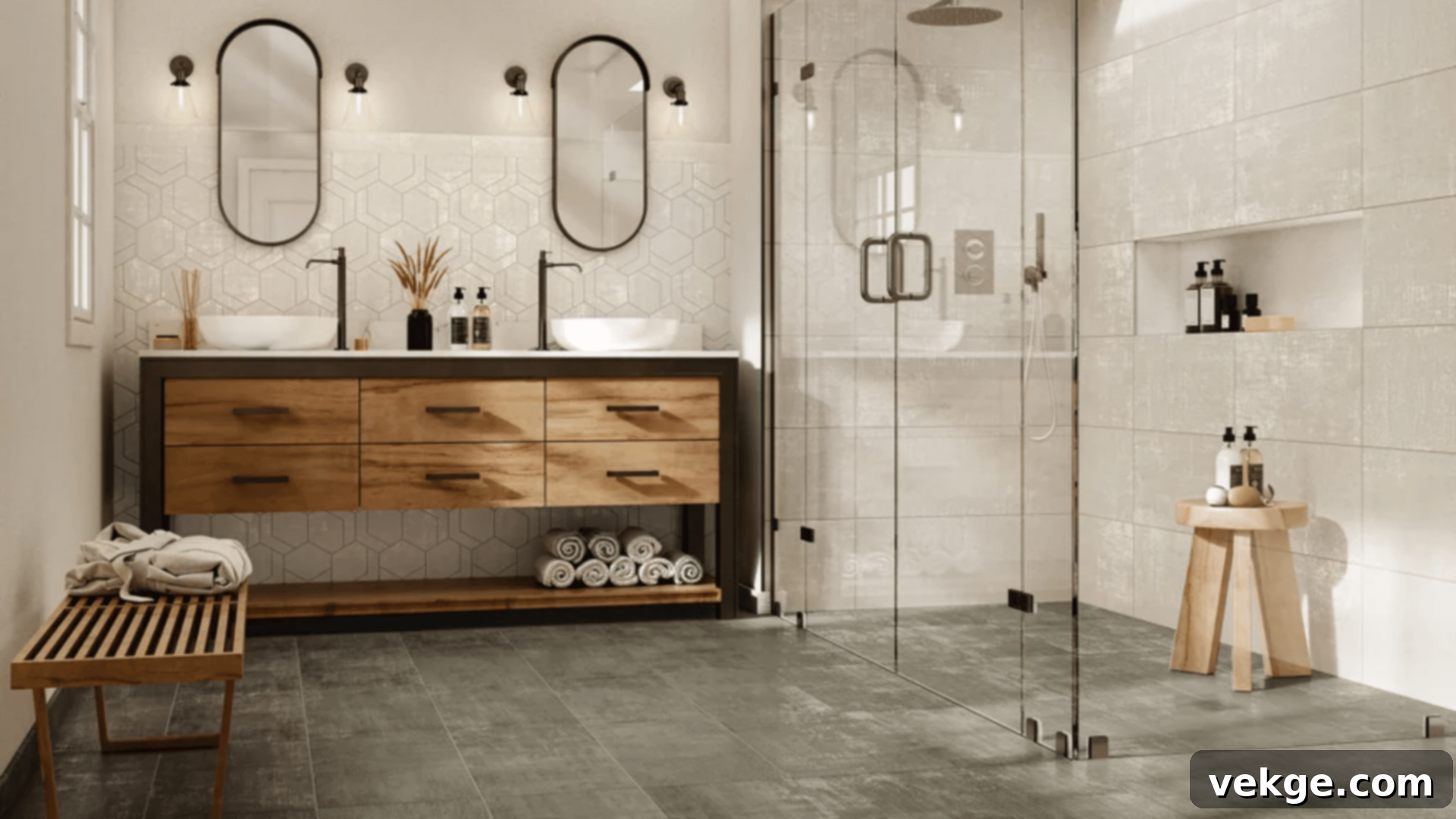
The curbless shower is perhaps one of the most impactful and aesthetically pleasing features in an aging-in-place bathroom. By eliminating the raised threshold or “curb” at the shower entry, it creates a seamless transition from the bathroom floor directly into the shower area. This design virtually removes a major tripping hazard, making it incredibly safe for individuals with limited mobility, those using walkers, or even wheelchairs to roll directly into the shower.
Water containment is achieved through a subtle slope in the shower floor towards a linear or central drain, often complemented by a glass partition or a shower curtain. Beyond its undeniable safety benefits, a curbless shower offers a sleek, modern, and open aesthetic that can make even a small bathroom feel more expansive and luxurious, adding significant value and appeal to the home.
16. Hands-Free Motion-Activated Lighting
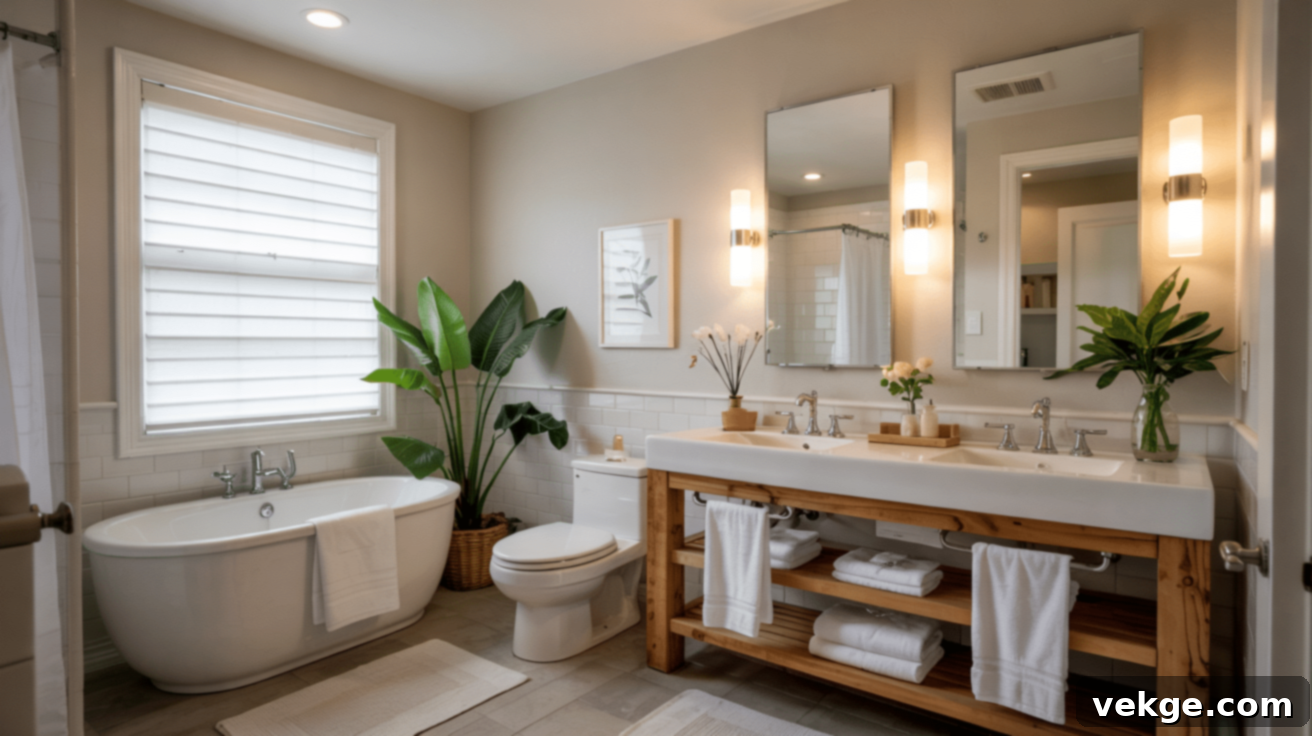
Navigating a dark bathroom, especially in the middle of the night, poses a significant fall risk. Motion-activated lighting automatically illuminates the space upon entry, eliminating the need to fumble for light switches. This is particularly beneficial for individuals with impaired vision, limited hand dexterity, or those who are disoriented in the dark.
These smart lighting systems can be configured to provide a soft, ambient glow during nighttime hours, preventing the jarring effect of bright lights while still offering sufficient visibility. In addition to their safety advantages, motion-activated lights are also energy-efficient, turning off automatically when the room is vacant, ensuring that lighting is only used when and where it’s needed.
17. Gentle Guiding Night Lights
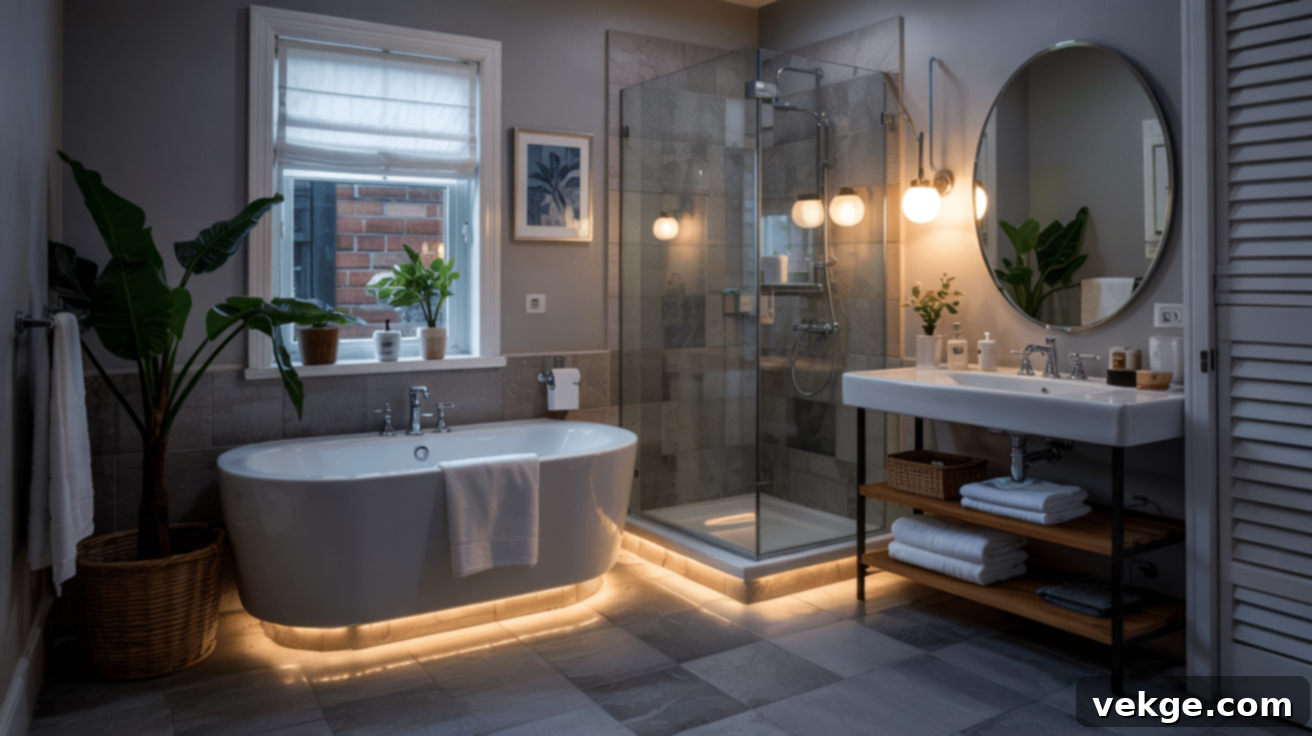
For those late-night trips to the bathroom, harsh overhead lighting can be disorienting and disruptive to sleep. Strategically placed night lights, typically installed at a low level along pathways or near fixtures, offer a soft, subtle illumination that guides the way without being overly bright.
These low-level lights help maintain nocturnal vision and prevent falls by clearly marking paths and identifying potential obstacles when one isn’t fully awake. They consume minimal energy and can be easily plugged into outlets or integrated into the bathroom’s electrical wiring for a seamless look. Night lights are a simple, yet highly effective, addition to bolster safety in an aging-in-place bathroom.
18. Focused Task Lighting
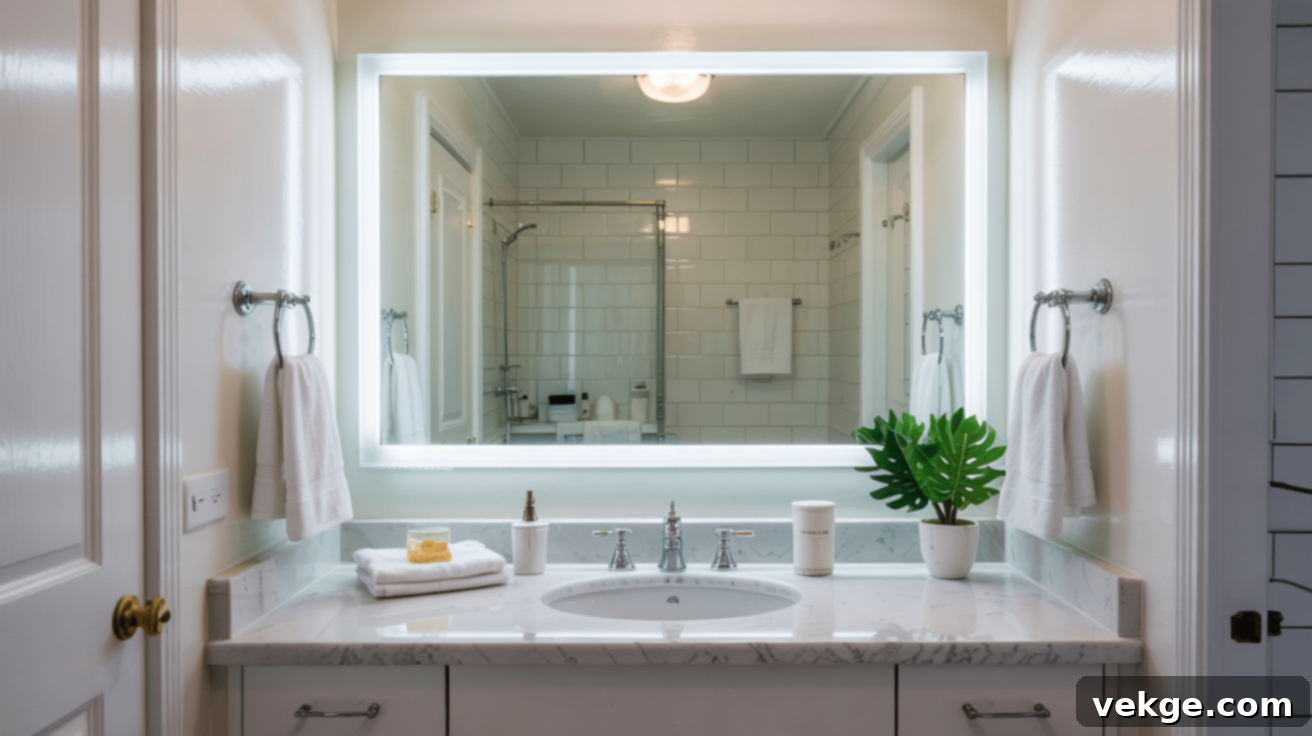
General overhead lighting is often insufficient for detailed tasks performed at the vanity. Dedicated task lighting, strategically placed around the mirror, provides bright, focused illumination exactly where it’s needed for grooming activities like shaving, applying makeup, or managing medications. This type of lighting is designed to reduce shadows and glare, minimizing eye strain and improving precision.
For optimal results, task lights should ideally flank the mirror at eye level to provide even illumination across the face, rather than just from above, which can cast unflattering shadows. Properly implemented task lighting makes daily routines more accurate, safer, and significantly more comfortable, enhancing the overall functionality of the bathroom vanity area.
19. Secure Non-Slip Flooring
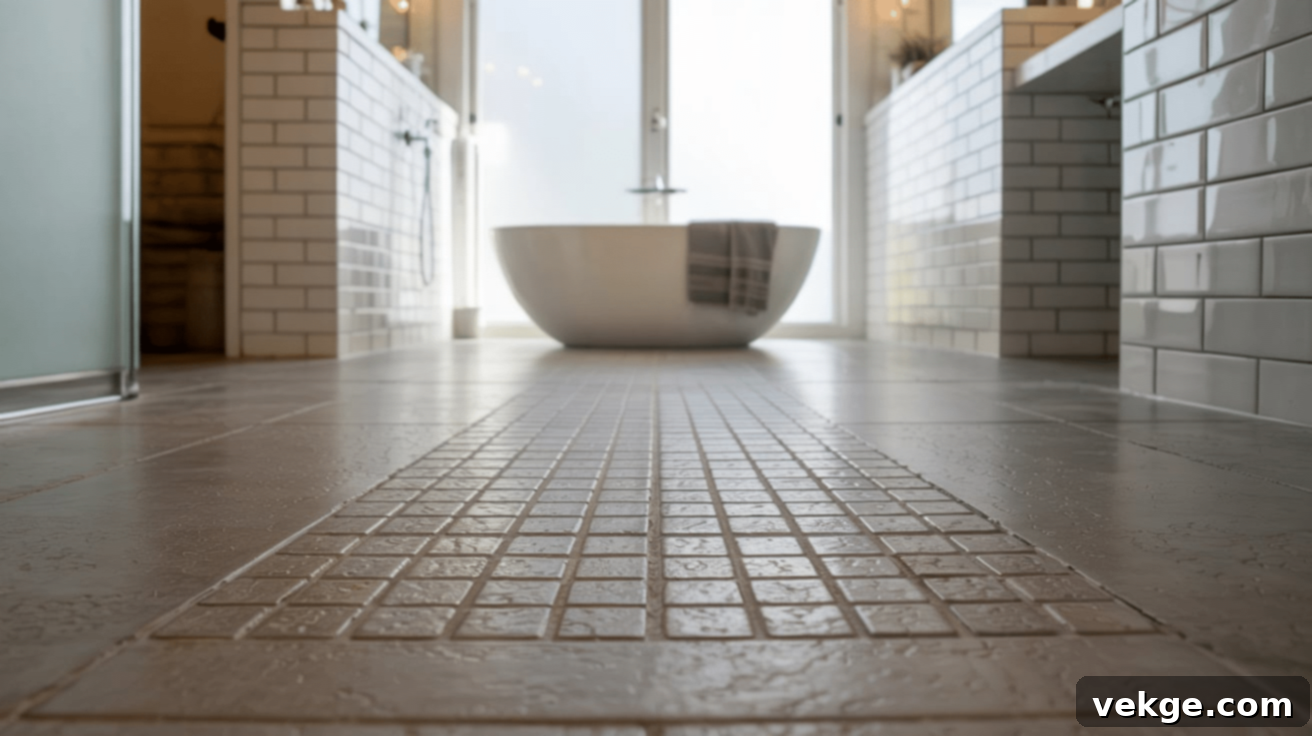
The choice of flooring is paramount in preventing slips and falls, which are among the most common bathroom accidents, especially when surfaces are wet. Non-slip flooring materials feature a higher coefficient of friction, providing superior grip even in moist conditions. Options include textured ceramic or porcelain tiles, vinyl, or specific types of treated stone.
Modern non-slip flooring options are far from the utilitarian looks of the past; they come in a vast array of colors, patterns, and finishes that can mimic natural wood, stone, or contemporary designs, allowing for both safety and sophisticated aesthetics. Investing in high-quality non-slip flooring is a foundational step in creating a truly safe and fall-resistant aging-in-place bathroom, offering peace of mind with every step.
20. Essential Non-Slip Rugs and Mats
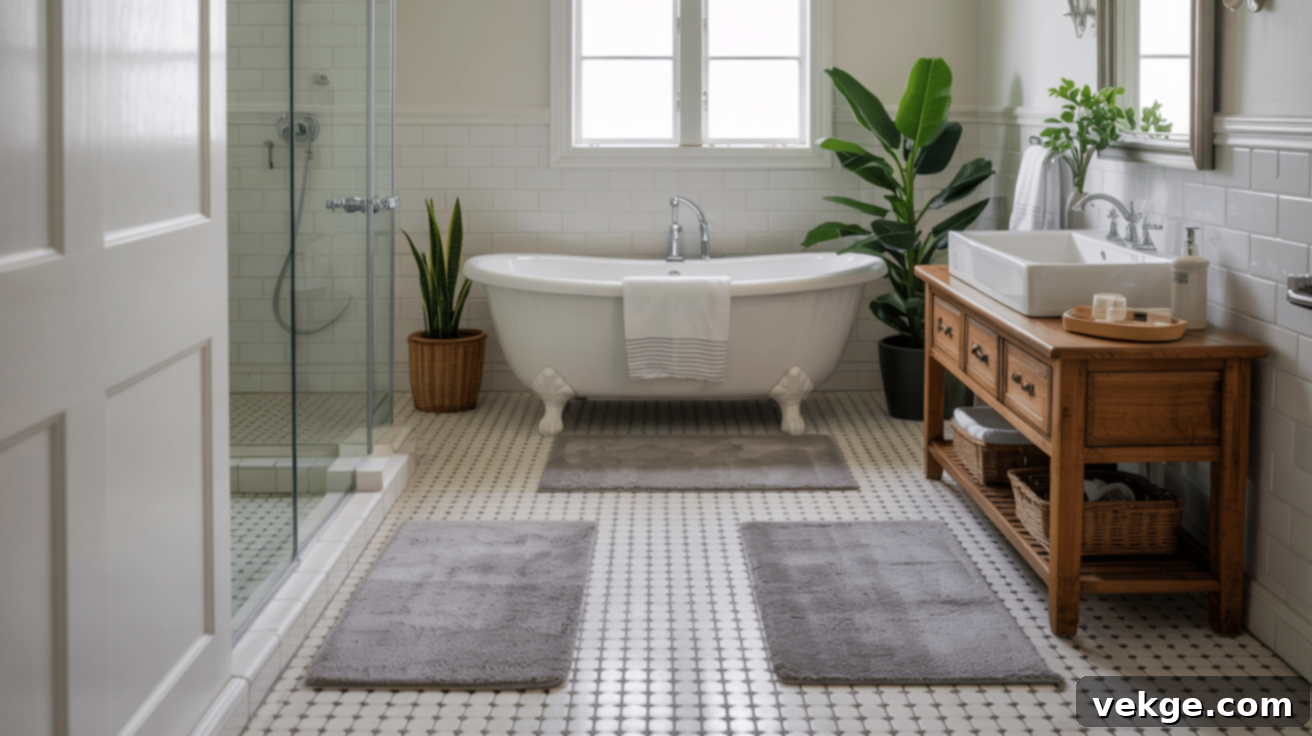
Even with non-slip flooring, targeted areas like directly outside the shower, bath, or in front of the sink can benefit from additional traction. Non-slip rugs and mats are designed with rubberized or silicone backings that firmly grip the floor, preventing them from sliding or bunching up, which can be a significant tripping hazard.
Beyond their primary safety function, these rugs provide a warm, soft surface for bare feet, adding an element of comfort to the bathroom. When selecting non-slip rugs, it’s crucial to choose ones with low profiles or beveled edges to further minimize any potential for tripping, ensuring they enhance safety without introducing new risks.
21. Enhanced Grip with Textured Shower Walls
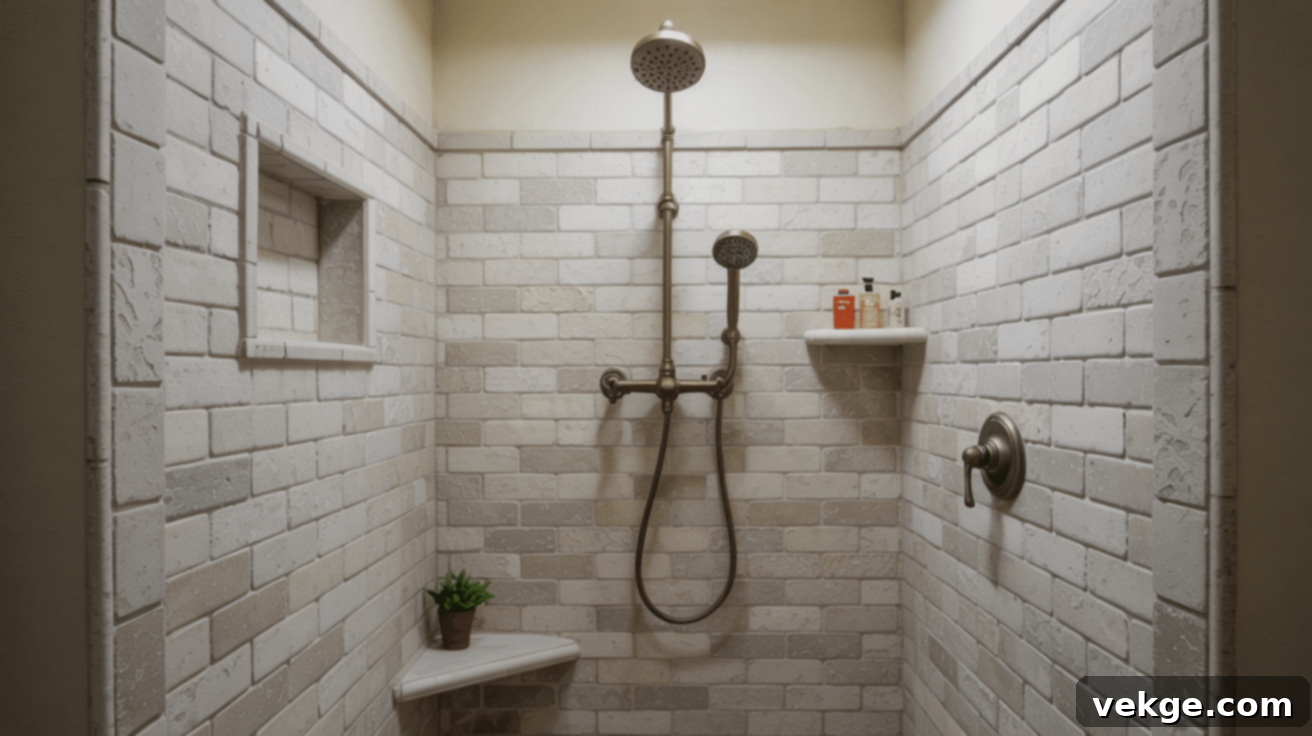
While grab bars are essential, integrating subtle textured surfaces into shower walls offers an additional layer of security and comfort. A slight texture, whether from specific tile choices, stone, or engineered panels, provides a tactile grip that can be incredibly reassuring for wet hands seeking support. This subtle resistance can help prevent slips or falls by giving users something reliable to hold onto, even instinctively.
Textured shower walls are not just functional; they also add significant visual interest and depth to the bathroom design. Available in a wide range of materials and patterns, they can be chosen to complement your overall aesthetic, proving that safety features can be beautifully integrated into a sophisticated and inviting space without looking clinical.
Essential Maintenance Tips for Long-Term Bathroom Safety and Functionality
An aging-in-place bathroom is an investment in long-term safety and independence. To ensure these critical features continue to perform effectively, consistent maintenance is absolutely vital. Over time, even the most robust installations can experience wear and tear, and neglecting routine checks could compromise the very safety you’ve worked to establish. Proper upkeep not only extends the life of your bathroom components but, more importantly, guarantees that your space remains a reliable haven free from preventable hazards.
Here’s a detailed guide to key maintenance tasks that will keep your aging-in-place bathroom in optimal condition:
- Regular Grab Bar Inspection: Monthly, or even more frequently with heavy use, perform a simple yet crucial check on all installed grab bars. Gently apply pressure or pull on them to ensure they remain absolutely secure and firmly attached to the wall. Look for any signs of loosening screws, wall damage around the anchors, rust, corrosion, or excessive wear on the finish that could weaken their structural integrity. Tighten any loose fasteners immediately and consider professional re-installation if you notice significant wobbling or damage.
- Functional Check of Adjustable Features: For features like height-adjustable sinks, movable shower heads, or pull-down shelves, it’s essential to regularly test their smooth operation. Ensure they move freely without sticking and lock securely into their intended positions. If you notice any stiffness, squeaking, or difficulty in adjustment, apply a suitable, non-toxic lubricant according to manufacturer guidelines. Regular cleaning of tracks and mechanisms can also prevent debris buildup that might impede movement.
- Proper Care for Non-Slip Flooring: Non-slip properties are crucial for fall prevention. Weekly cleaning of your non-slip floors is necessary to prevent soap scum, dirt, or other residues from reducing their grip. Always use cleaning products specifically recommended for your flooring type that will not damage the texture or coating designed to enhance traction. Critically, avoid all wax-based cleaners or polishes, as these can create a dangerously slippery film, negating the safety benefits of your specialized flooring.
- Comprehensive Lighting System Check: Good lighting prevents accidents. Regularly inspect all light fixtures, including overhead lights, task lighting, night lights, and motion-activated sensors. Promptly replace any burnt-out bulbs to maintain consistent illumination levels. For motion sensors, routinely test their responsiveness by walking into the room or waving your hand in front of them. Keep sensor surfaces clean and free of dust or obstructions, which can interfere with their detection capabilities.
- Proactive Leak Detection and Repair: Water leaks can lead to significant problems, including mold growth, structural damage to subflooring (which can compromise grab bar anchors), and slippery puddles. Monthly, check thoroughly under sinks, around the base of toilets, and near shower/tub enclosures for any signs of moisture, drips, or water stains. Even minor leaks should be addressed immediately by a qualified plumber to prevent them from escalating into costly repairs and potential safety hazards.
Emerging Trends in Stylish and Functional Aging-in-Place Bathroom Design
The landscape of aging-in-place bathroom design is continually evolving, moving far beyond purely utilitarian solutions to embrace aesthetics, technology, and personal luxury. Today’s trends reflect a desire for spaces that are not only highly functional and safe but also sophisticated, comfortable, and seamlessly integrated into the overall home design. The focus is on creating environments that feel spa-like and inviting, rather than clinical, and that can adapt gracefully as needs change over time.
- Smart Home Integration & Advanced Technology: The rise of smart home technology has profoundly impacted bathroom design. This includes:
- Smart Toilets: Featuring built-in bidets, heated seats, automated flushing, night lights, and self-cleaning mechanisms, smart toilets offer unparalleled hygiene, comfort, and convenience, drastically reducing the need for reaching or straining.
- Digital Shower Systems: Advanced digital controls allow users to pre-set desired water temperatures, flow rates, and even activate multiple spray heads with a single touch, preventing scalding and enhancing the showering experience.
- Voice-Activated Controls: For lighting, exhaust fans, or even music, voice-activated systems provide hands-free operation, a significant benefit for individuals with limited mobility.
- Luxury Finishes with Enhanced Safety: There’s a strong trend towards using high-end materials that also boast excellent safety features:
- Luxury Vinyl Plank (LVP) and Tile (LVT) Flooring: These materials offer the sophisticated appearance of natural wood or stone, but with inherent non-slip properties, warmth, and water resistance, making them ideal for safe and stylish bathroom floors.
- Textured Tiles and Finishes: Beyond just flooring, textured wall tiles (especially in showers) provide subtle grip points and add depth and visual interest without compromising safety.
- Hidden Accessibility Features: Modern designs cleverly integrate safety elements so they are discreet and elegant:
- Stylish Grab Bars: No longer industrial-looking, grab bars are now available in designer finishes and shapes that blend seamlessly with high-end fixtures, often doubling as towel bars or toilet paper holders.
- Sleek Curbless Showers: These are a design preference for many homeowners due to their clean lines and spacious feel, inherently offering superior accessibility without appearing “modified.”
- Spa-Like Amenities and Comfort: Creating a luxurious and therapeutic environment is key:
- Radiant Floor Heating: Provides soothing warmth, a comfort often appreciated by older adults, and helps dry floors faster.
- Ergonomic Design: From comfort-height toilets to thoughtfully placed storage, every element is considered for ease of use and maximum comfort without sacrificing aesthetics.
- Ample Natural Light and Biophilic Design: Maximizing natural light and incorporating natural elements like plants or wood tones creates a calming and restorative atmosphere.
The overarching theme in current aging-in-place bathroom design is personalization and integration. Homeowners seek bathrooms that not only cater to present and future physical needs but also reflect their personal style and enhance the overall value and livability of their home. These spaces are designed to support a lifetime of comfortable, independent living, proving that practical considerations can absolutely coincide with beautiful design.
Embrace Independent Living: Your Journey to an Ideal Aging-in-Place Bathroom
The journey to creating an aging-in-place bathroom is a powerful step towards securing your long-term comfort, safety, and independence within the familiar embrace of your own home. As we’ve explored, this thoughtful design approach is far more than a set of practical modifications; it’s about proactively adapting your living space to support your evolving needs, ensuring that your bathroom remains a source of relaxation and ease, not a hidden hazard.
From the foundational elements of accessibility, safety, and comfort, to the myriad of smart design tips like curbless showers, accessible storage, and intelligent lighting, every choice you make contributes to a more supportive environment. Remember that transformations don’t always require a complete overhaul; even small, incremental changes – such as adding robust grab bars, updating to lever handles, or integrating non-slip mats – can make a profound difference in daily safety and functionality.
As you plan for more significant upgrades, consider the lasting benefits of features like height-adjustable fixtures or a spacious, open floor plan. Crucially, commit to regular maintenance of all safety features to ensure they remain dependable and effective over time. For personalized guidance tailored to your specific needs and bathroom layout, consulting with a certified aging-in-place specialist or an experienced designer is highly recommended.
Ultimately, an investment in aging-in-place bathroom design is an investment in your future well-being and quality of life. It’s about cultivating peace of mind, preserving your autonomy, and extending the joy of living in your cherished home for many years to come. Isn’t the confidence that comes with a safe, comfortable, and independent bathroom truly invaluable?
We invite you to share your thoughts, experiences, or questions about aging-in-place bathrooms in the comments below. Your insights could help others on their journey!
